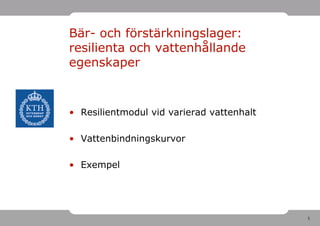Session 68 Jonas Ekblad
- 1. Bär- och förstärkningslager: resilienta och vattenhållande egenskaper • Resilientmodul vid varierad vattenhalt • Vattenbindningskurvor • Exempel 1
- 2. Slutsatser: • Så länge som de obundna lagren är omättade är huvuddelen av dessa lager vid relativt låg mättnadsgrad • Vid normala spänningsnivåer och under dränerade förhållanden är förändringen i resilientmodul måttlig vid varierad vattenhalt (eller tensionsnivåer) 2
- 3. Material: Skärlunda 100 90 mm 90 63 mm 80 Passerad mängd [vikt-%] 70 60 50 40 30 20 10 0 0.063 0.125 0.25 0.5 1 2 4 8 16 31.5 63 90 Storlek [mm] 3
- 4. Mekaniska mätningar 4
- 5. Provning • Låg vattenhalt (15 kPa) • Max vattenhållande • Mättat (eller dränkt) • Dränerat 5
- 6. J o r d yt a Hydrauliska mätningar 1 0 0 T D R p r o b T e n sio m e t e r 2 5 0 1 0 0 5 0 0 1 0 2 0 0 6
- 7. Relativ modul 1.2 1 Relativ modul [Pa/Pa ] 0.8 0.6 0.4 Låg vattenhalt Maxgräns 0.2 Dränerat Vattenmättat 0 0 50 100 150 200 Medelnormalspänning, p [kPa] 7
- 8. Resilienta resultat 90 mm 63 mm 1.0 Relativ modul q 0.8 0.6 0.4 0.2 0.0 Låg vattenhalt Vattenhållande Mättat/dränkt Dränerat gräns 8
- 9. Retentionsresultat 1.0 0.9 90 mm 0.8 63 mm Vattenmättnad 0.7 0.6 0.5 0.4 0.3 0.2 0.1 0.0 0 5 10 15 20 25 30 35 40 45 50 Tension [kPa] 9
- 10. Exempel: statiskt, inga flöden Grundvattenyta: Underkant 30 cm under 100 cm under Vattenmättnad Vattenmättnad Vattenmättnad 0.00 0.25 0.50 0.75 1.00 0.00 0.25 0.50 0.75 1.00 0.00 0.25 0.50 0.75 1.00 0 0 0 Bärlager Bärlager Bärlager 5 5 5 10 Förstärknings 10 Förstärknings 10 Förstärknings 15 lager 15 lager 15 lager Djup [cm] Djup [cm] Djup [cm] 20 20 20 25 25 25 30 30 30 35 35 35 40 40 40 45 45 45 50 50 50 10
- 11. Slutsatser: • Så länge som de obundna lagren är omättade är huvuddelen av dessa lager vid relativt låg mättnadsgrad • Vid normala spänningsnivåer och under dränerade förhållanden är modulens beroende av vattenhalt måttligt 11



![Material: Skärlunda
100 90 mm
90 63 mm
80
Passerad mängd [vikt-%]
70
60
50
40
30
20
10
0
0.063 0.125 0.25 0.5 1 2 4 8 16 31.5 63 90
Storlek [mm]
3](https://image.slidesharecdn.com/session68jonasekblad-111128034850-phpapp02/85/Session-68-Jonas-Ekblad-3-320.jpg)



![Relativ modul
1.2
1
Relativ modul [Pa/Pa ]
0.8
0.6
0.4 LĂĄg vattenhalt
Maxgräns
0.2 Dränerat
Vattenmättat
0
0 50 100 150 200
Medelnormalspänning, p [kPa]
7](https://image.slidesharecdn.com/session68jonasekblad-111128034850-phpapp02/85/Session-68-Jonas-Ekblad-7-320.jpg)

![Retentionsresultat
1.0
0.9 90 mm
0.8
63 mm
Vattenmättnad
0.7
0.6
0.5
0.4
0.3
0.2
0.1
0.0
0 5 10 15 20 25 30 35 40 45 50
Tension [kPa]
9](https://image.slidesharecdn.com/session68jonasekblad-111128034850-phpapp02/85/Session-68-Jonas-Ekblad-9-320.jpg)
![Exempel: statiskt, inga flöden
Grundvattenyta:
Underkant 30 cm under 100 cm under
Vattenmättnad Vattenmättnad Vattenmättnad
0.00 0.25 0.50 0.75 1.00 0.00 0.25 0.50 0.75 1.00 0.00 0.25 0.50 0.75 1.00
0 0 0
Bärlager Bärlager Bärlager
5 5 5
10 Förstärknings 10 Förstärknings 10 Förstärknings
15 lager 15 lager 15 lager
Djup [cm]
Djup [cm]
Djup [cm]
20 20 20
25 25 25
30 30 30
35 35 35
40 40 40
45 45 45
50 50 50
10](https://image.slidesharecdn.com/session68jonasekblad-111128034850-phpapp02/85/Session-68-Jonas-Ekblad-10-320.jpg)




























